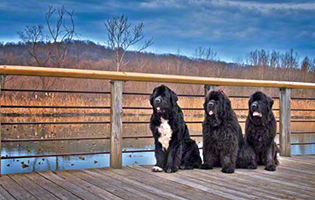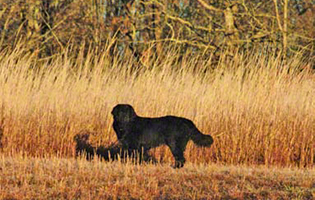AN UPDATE by
Barbara Jenness; with Pat Randall; & Jennifer Zablotny, DVM
Reprinted from 1st Quarter NewfTide 2014

A BRIEF HISTORY... Early in 1998, NCA member Barbara Jenness, with input from NCA member and breeder Peggy Helming, contacted Michigan State University regarding a deformity of the front legs reported in the Newfoundland breed. As information was gathered, it became apparent that the problem had been seen all over the country and abroad. Differing diagnoses and lack of a central clearing house to report the problem masked how wide spread the condition was.
Armed with several x-rays of affected animals, Barbara Jenness met with Dr. Ulreh Mostosky, DVM, and Dr. George Padgett,DVM, of Michigan State University to engage their help in determining what was going on in these puppies and what could be done. An initial report of their findings was published in Newf Tide in 1998 and, in this article, the condition was referred to as elbow anomaly. After x-raying nine affected, puppies Dr. Mostosky noted that there was asynchronous (uneven) growth of the radius and ulna coupled with subluxation of the elbow. It
After this period of data collection, another report appeared in Newf Tide in 1999. This report included x-rays and photos of affected animals and reported the incidence of the disease and suspected mode of inheritance. It also coined the name Newfoundland Forelimb Anomaly (FLA/CRHL), which was felt to be a more accurate description of the problem. Based on the collected data and suspected mode of inheritance, a test breeding of two affected animals was done. The male was housed at a veterinary clinic, and semen was collected for insemination. The female was housed by an NCA member and was brought to the clinic for insemination. Shortly after the breeding, the male was euthanized. This breeding produced two live puppies. After x-raying the puppies every week for two months, it was determined that both had normal forelimbs, which was not the expected outcome from this breeding. These surprising results made it evident that researchers were not dealing with a simple recessive and finding a genetic marker would be more complicated than anticipated. After this breeding and the follow-up x-rays on the puppies, research and interest stalled. Due to the demands of a growing dairy and cheese-making business, Barbara Jenness, central contact person, turned over information to the NCA Health and Longevity (H &L) Committee; Dr. Padgett passed away in 2004; and Dr. Mostosky retired in 2008. Dr. Mostosky continued to work on the Newfoundland Forelimb Anomaly after his retirement, funding it himself. He also accepted and read x-rays from around the world. Working with NCA member and breeder, Kathy Whitney, he helped facilitate a second breeding of affected-to-affected animals. The second litter confirmed the results of the first breeding, producing six normal puppies. These puppies were x-rayed every other week from three to 12 weeks of age. In July 2012, Dr. Mostosky suffered a major stroke; in August 2012, Dr. Mostosky’s home facility burned and the building was a total loss. Twenty years of research were destroyed, including all his records on FLA/CRHL. This was a tragic loss. Fortunately, during his years of research, the DNA he collected on affected and non-affected animals had been stored with OFA and, therefore, was preserved. According to current reports, Dr. Mostosky’s recovery is progressing and he continues to read radiographs. This brief history shows that the disease has been around for many years, and it continues to be in evidence today. There have been sporadic reports to the H & L Committee over the years, and, more importantly, there appears to be a recent spike in the number of affected litters. FLA/CRHL has lacked a cheerleader over the last decade, and it is time that Newfoundland owners and breeders push for more awareness and continued research.
|
WHAT WE KNOW ABOUT FLA/CRHL . . . FLA/CRHL is frequently misdiagnosed, which adds to the confusion surrounding the problem, and a similar disease has been noted in Nova Scotia Duck Tolling Retrievers. It is complex, the mode of inheritance has not yet been determined, and there is no cure. The severity of the condition varies from mildly affected to severe and can be unilateral or bilateral. Affected animals can be diagnosed as early as four weeks of age by anterposterior (directed from the front to the back) and lateral |
THE GENETICS ...
Evidence regarding the inheritance of the forelimb anomaly is still absent from the peer-reviewed literature. In view of the radiological evidence above, it does appear to be a discrete, recognizable entity, though it may vary in severity.
To the eye of an experienced observer, it is unlikely to be mistaken for any of a variety of forelimb or elbow problems present in Newfoundlands or other breeds and should lend itself to formal genetic analysis.
The breed predilection (to date only Newfoundlands and Duck Tolling retrievers) provides prima facie evidence of a strong genetic component, but this has yet to be verified with more refined methods. The previous data published in Newf Tide suggested that the malformation might be recessive since two unaffected dogs can produce affecteds (21 instances in this study alone) and examination of litters with at least one affected suggested that the overall ratio of unaffected to affected was not significantly different from the nominally expected 3:1. Obviously, the litter resulting from breeding two affecteds virtually rules out a simple recessive, e.g., six puppies all unaffected. Two affecteds should not produce even one unaffected since there would be no source of the normal allele.
A retrospective analysis of the Newf Tide data reveals that the inheritance does, in fact, differ from expectation for a simple recessive. Although the overall ratio of unaffected to affected approximates 3:1, there is significantly more variation between litters than would be expected for a simple recessive. Litters of 7 out of 9 and 6 out of 7 alone would be extraordinarily unlikely in a sample of 21 carrier-to-carrier breedings. This can be contrasted to many litters from two presumptive carriers
with few or no affected puppies. Across the entire data set, the simple recessive hypothesis can be rejected with a high degree of certainty (p=.001).
This pattern may give us some direction in our search for a solution to the forelimb anomaly. The mechanism must be one, which might have systematic “litter effects.” Different litters from the same parents have had very different results, e.g., 12 unaffected: 0 affected in one breeding and 4 unaffected: 3 affected in the next. Litters from apparently similar breedings in the original study range from 1 of 12 to 7 of 9. This suggests that some factor is acting at the level of the litter. A likely possibility would be a genetic factor (gene or genes) that results in the vulnerability to an environmental trigger that is present in some litters and absent in others. This could appear as an incompletely penetrant recessive (or possibly even dominant) where the penetrance varies systematically from litter to litter.
WHERE WE GO FROM HERE . . .
Recently several Newfoundland owners and breeders (Denise Castonguay; Denise Hatakeyama; Peggy Helming; Barbara Jenness; Amy Lane; Pat Randall; Debra Wigal, DVM; Renee Woods; Jennifer Zablotny, DVM;) have formed a small group committed to raising awareness about Newfoundland Forelimb Anomaly through education. The group will encourage continued data and blood collection for future research and the development of guidelines for help in early diagnosis. This
group needs help from owners and breeders of affected puppies and anyone with an interest in Newfoundland health. Help us make sure that data has been collected and a DNA sample has been collected and banked on all affected dogs. Breeders who have had affected litters should ensure that all data requested is recorded. If you are unsure of a diagnosis, we will provide you with information for submitting an x-ray.
The FLA/CRHL Group can be contacted via email at forelimbanomaly@gmail.com or the website at www.newfoundlandforelimbanomaly.com
Resources
www.newfoundlandforelimbanomaly.com
www.sulathenewfie.com
newfoundlandforelimbanomaly@gmail.com
Bibliography
Groondalen, J. A generalized chrondropathy of joint cartilage leading to deformity of the elbow joints in a litter of Newfoundland dogs. Journal of Small Animal Practice. 1981 Aug; 22(8): 523-38.
Jenness, B. Update: Congenital Elbow Anomaly. Newf Tide, 1998.
Padgett G., Mostosky U., Jenness B. Preliminary report on the determination of the mode of inheritance of a forelimb anomaly in Newfoundlands. Newf Tide, Second Quarter, 1999: 64-65.

